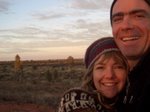
We had heard (and seen) the salt flats were at least partly covered with (salt) water, so we were not keen to take our precious and trustworthy bike out there without knowing how much water, and how deep. To check out the conditions, and also for the experience of a guided tour with other tourists, we took a one-day tour onto the Salar. Ordinary tour, though the place itself is a total blowout and the mob we were with were good value. We took advantage of the total flatness to do some photographic shenanigans together.
The tour got us back to town in the early evening, but we had decided that a night out on the flats themselves was not to be missed. In a massive hurry to catch the last light, we packed our steed and headed out, excited like kids about spending the night in another world. Made time to buy food supplies and some boxed wine, though this latter tasted rather odd come dinner time.
The trip out to the Salar, started in the dark, was short but about the most manic and beautiful of any in this epic year of motorcycle travel. At least llamas have decent road sense; more of a concern were the cars and trucks without lights, the choking dust, and the (by now normal) horrendous corrugations, bulldust and sand drifts. The shortcut around the somewhat hostile little town at the edge of the salar was exciting - across railway tracks, then fields, then salt, following telephone poles or just aiming for the lights of the buildings at the very edge of the salt.
Crossing the waterlogged part of the salt was a nervous challenge - dropping the bike into a puddle of salt water at night was to be avoided. Emily walked ahead into the darkness, avoiding the deep pools to choose a path for me to pick along with the bike. She got us there, through about 300m of very dodgy terrain, without wetting a tyre!
Cruising across this white, featureless plain at night on a motorcycle is recommended adventuring! Wow! I just rode, keeping an eye out for depressions, holes or soft patches in the salt, while Emily navigated by the stars. With landmarks totally absent, we headed slight left of the sword of Orion until the hunter was obliterated by cloud, then just kept the beautiful Southern Cross at our left shoulders. The dark, cold air of high altitude touched our faces, chilled our hands and thrilled our souls. The hard salt crunched beneath our wheels, and we rode on, on towards the edge of the world. Stars shone above, salt below, and we flew on.
Thirty or so kilometres, we don't really know how far. As on most days we ride, we just rode until we felt like camping up. We stopped, first running around like kids, exhilarated by the stars, the white salt, the feel of it beneath our feet, our distance from the rest of the world. Then we bathed in what felt like utter silence until the chill of the night and the ride reminded us to get cracking with tent and dinner.
We got a bit of a start when we heard odd noises, just after dinner and the odd wine, but sitting in silence for a few minutes convinced us that what we could hear were birds. Both their voices and the flapping of their wings.
The morning gave us the salt flat, its enormity and beauty...
and another reminder of our own teency, tiny scale!
And though in some respects it lacked the excitement of the night before, the ride off the Salar de Uyuni was pretty good too!














 The morning brought a sunrise walk
The morning brought a sunrise walk then lazy visits to languid villages in this harsh and spectacular Jujuy region of Argentina.
then lazy visits to languid villages in this harsh and spectacular Jujuy region of Argentina.  Lunch in Humahuaca - later to become Em's and my home town - set us up for the afternoon's ride. Through 3000m, stock up at dusty Abra Pampa on the Puna, or high plains of Jujuy. Aiming for the Laguna de los Pozuelos in the hope of spying pink flamingos, we left the asphalt and went up again, gradually, to over 4000m.
Lunch in Humahuaca - later to become Em's and my home town - set us up for the afternoon's ride. Through 3000m, stock up at dusty Abra Pampa on the Puna, or high plains of Jujuy. Aiming for the Laguna de los Pozuelos in the hope of spying pink flamingos, we left the asphalt and went up again, gradually, to over 4000m. 
 At one stage we were overtaken by a mob of blokes from New Zilland, travelling on bikes and in a hurry to stick to their schedule.
At one stage we were overtaken by a mob of blokes from New Zilland, travelling on bikes and in a hurry to stick to their schedule. They seemed keen to spray us with their story when we stopped for a yarn, then they had to go. A couple of photo stops and a steak sandwich (A only!) later, and we bounced into Salta (whose name means "jump").
They seemed keen to spray us with their story when we stopped for a yarn, then they had to go. A couple of photo stops and a steak sandwich (A only!) later, and we bounced into Salta (whose name means "jump").


















 We grabbed our passports from the Gendarmeria Nacional, and headed back to relative lowlands. One more bit of intense riding, on sand this time, got us to a wild camp amongst towering white sandstone gorges.
We grabbed our passports from the Gendarmeria Nacional, and headed back to relative lowlands. One more bit of intense riding, on sand this time, got us to a wild camp amongst towering white sandstone gorges. 














